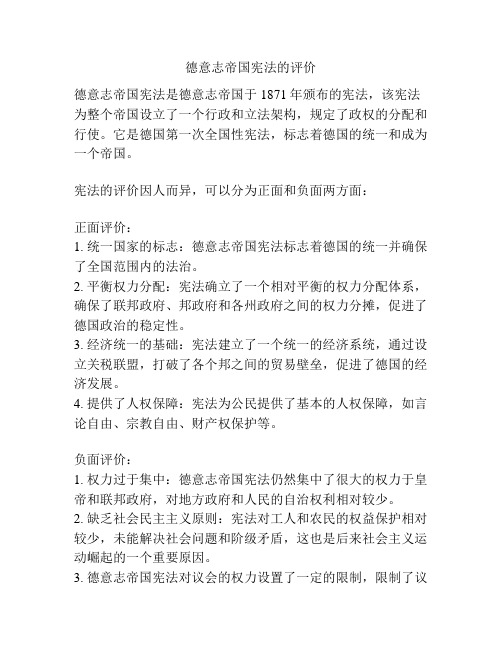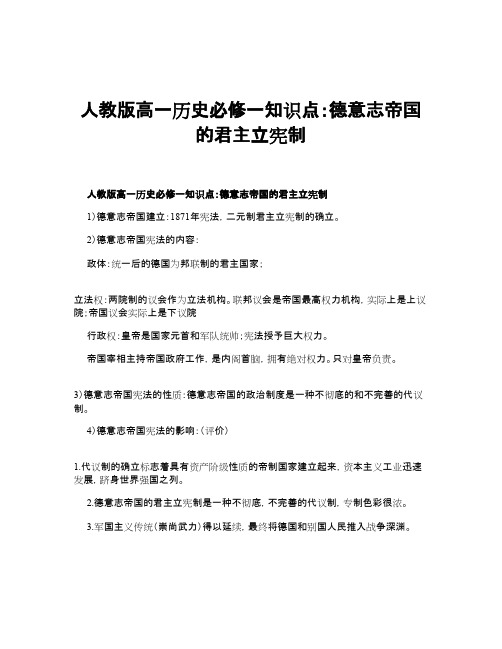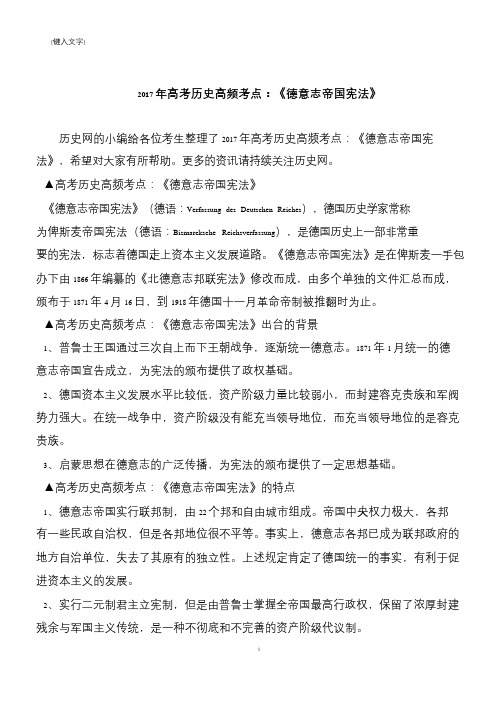德意志帝国宪法
德意志帝国宪法(魏玛宪法)

第三十二条联邦国会之表决,除宪法规定其他投票比例外,应以过半数行之。
但联邦国会内所行之选举,得依照议事细则为例外之规定。
决议能力,由议事细则规定之。
第三十三条联邦国会及其委员会,得要求联邦行政院长及各部部长出席。联邦行政院长,各部部长及其所委托之人员,均得出席于联邦国会及其委员会之会议,各部亦得派遣全权代表出席此会议,以陈述各该邦政府对于某议案意见。
5.埋葬制度。
第十一条联邦对于各邦赋税之征收与征收之种类,如认为必要时,得以立法手续,以章则规定其性质及征收方法,使得保持重要之社会利益及免除下列弊病。
1.有害于联邦税源或联邦商业者。
2.两重赋税。
3.苛税,或使用公共交通孔道,及足以增加运输负担之不应有捐税。
4.各邦间或同邦各地间贸易之捐税,其足以使输入货较土制货物难销售者。
第三条联邦旗色为黑红金三色,商旗为黑白红三色,其上内角镶国旗。
第四条已公认之国际法上各法规,得视为德意志联邦法律,有裁制力。
第五条国权之关于联邦事务者,由联邦之机关,依照联邦宪法行使之。
关于各邦事务者,由各邦机关,依照各邦宪法行使之。
第六条下列各立法权为联邦所专有:
1.外交。
2.殖民制度。
3.国籍,自由移住移民,引渡。
第十四条联邦法律无其他特别规定时,由各邦官署执行之。
第十五条联邦政府对于联邦有立法权事项,行使监督权。联邦法律,由各邦官署执行时,联邦政府得发布通命,联邦政府为监督各邦中央官署及其下级官署,执行联邦法律起见,有派遣委员于各邦中央官署之权,并在取得各邦中央官署同意时得派遣委员于各邦下级官署。
德意志帝国宪法的评价

德意志帝国宪法的评价
德意志帝国宪法是于1871年颁布并在帝国德国实施的一部基本法律文件,对于这一宪法的评价可以从多个角度来看。
首先,德意志帝国宪法的制定是奠定德国政治统一基础的重要一步。
该宪法是在普鲁士王国的领导下制定的,将26个德意志联邦各邦的主权权力有限的集中到了柏林。
这种集中的做法为德国的政治统一奠定了基础,也为后来的德国统一起了积极的推动作用。
其次,德意志帝国宪法对于帝国内部的权力分配和行政组织做出了一定规定。
宪法将权力划分为联邦层面和邦层面,确立了中央集权的原则,赋予联邦政府一定权力。
此外,宪法还规定了帝国议会的组成和议会议员的选举方式,为政治权力的运作提供了一定框架。
然而,德意志帝国宪法也存在一些不足之处。
首先,在决策过程中,联邦议会与君主的关系并不平衡,君主在某些方面仍然具有较大的权力。
其次,宪法并未给予人民充分的民主参与和权利保障,更多地体现了贵族和君主的利益。
这也导致了在后来的历史中,德国政治体制的进一步改革和民主化的迫切需求。
总体来说,德意志帝国宪法对于德国政治统一和行政组织的建立起到了重要的作用,但在权力平衡和民主参与方面还存在一定的不足。
这一宪法奠定了德国政治制度的基础,也为后来的德国宪法制定提供了重要的经验教训。
德意志帝国宪法(魏玛宪法)

第十二条对于联邦有立法权之事、在联邦不行使其立法权时,各邦得保留之。但对于联邦专有立法权之事,不在此例。
关于第七条第十三项各事,如各邦法律有损害联邦全体利益时,联邦有抗议权。
第十三条联邦法律得废止各部法律。
各邦法律与联邦法律发生疑义或有冲突时,联邦或各邦之中央主管官署得依照联邦法律之详细规定,请联邦最高法院判决之。
足以限制人身自由,至使议员不能行使其职权者,须得各该议员所属之议会之许可,始得为之。对于联邦国会或各邦议会议员之一切刑事诉讼或拘留及其余一切足以限制个人自由之拘束,如得其所属议会之要求时,应完全予以停止执行。
第三十八条联邦国会及各邦议会议员以议员资格受人委托,或因执行议员职务而以事委托他人时,对于该人及该事,有拒绝作证之权。关于没收书证,法律上允许某人有拒绝作证之权者,议员亦如之。
第九条在有发布统一法规之必要限度内,联邦对于下列各项有立法权:
1.公共福利之维护。
2.公共秩序及安宁之保护。
第十条联邦对于下列各事项,得以立法手续规定其章则:
1.宗教团体之权利及义务。
2.学校制度,包括高等学校制度及学术图书馆制度。
3.各种公共团体之公务员法规。
4.土地法,土地分配,居住地及家园制度,土地所有权之限制,住宅制度及人口分配。
民意以投票方法征求。如行将划分区域之居民,其有联邦国会选举权者1/3以上要求时,联邦政府应即下令举行人民投票。
对于领土变更或组织新部之决议,应有3/5之投票并代表有选举权者之过半数之赞同,始得决定之。其仅关于普鲁士行政区之一部分巴威亚邦之一部分或其他各邦相当行政区之一部分之划分,亦须征求各该区全部人民意见。划分之区域若与全区域不相关联者,得依照特别联邦法律,根据划分区域居民之意见行之。
德意志帝国的君主立宪制

政体 君主立宪制 民主共和制
宪法或 宪法性
《权利
文件 法案》
立法权 议会
1871年德意 1787年宪法 志帝国宪法
1875年宪法
议会 国会 议会
行政权 内阁 首相
皇帝 宰相
总统 总统
巩固练习:
• 1、下列关于《德意志帝国宪法》的规
定哪项不符合史实(
)
• A.宪法规定德国为联邦制的君主国家
• B.皇帝是国家元首,拥有巨大权力
▪【解析】C 德国皇帝属于世袭制,掌 ▪握国家各项大权,反映了德国君主立 ▪宪政体带有浓厚的专制色彩。
• 5、下列资产阶级法律文献反映该国民 主化程度不高的是( )
• A.美国1787年宪法 • B.法兰西第三共和国宪法 • C.1871年《德意志帝国宪法》 • D.1689年英国《权利法案》
产生
权力
行皇 政帝
世袭
国家元首和军队统帅,有权任
免官员、召集和解散议会和决 定对外政工作
立
联 邦 议
由各邦 代表组
法会成
权
帝 国
成年男子
议 选举产生
会
权力巨大,未经联邦议 会同意,任何法律均无 效
作用很小,通过的法案必 须得到联邦议会和皇帝的 批准
3、特点: A、行政权与立法权没有完全 分开;
二、德意志帝国的君主立宪制
1.1871年,德意志帝国宪法的颁 布,确立了德国君主立宪政体。
2.德意志帝国宪法(1871年)的内容
(1)联邦制国家 帝国政府掌握大权,地方拥有一
些自治权
“铁血首相”俾斯麦 当上了帝国首相
普鲁士国王威廉一 世当上了帝国皇帝
(2).德意志帝国宪法(1871年)的内容
德意志帝国宪法的评价

德意志帝国宪法的评价
德意志帝国宪法是德意志帝国于1871年颁布的宪法,该宪法为整个帝国设立了一个行政和立法架构,规定了政权的分配和行使。
它是德国第一次全国性宪法,标志着德国的统一和成为一个帝国。
宪法的评价因人而异,可以分为正面和负面两方面:
正面评价:
1. 统一国家的标志:德意志帝国宪法标志着德国的统一并确保了全国范围内的法治。
2. 平衡权力分配:宪法确立了一个相对平衡的权力分配体系,确保了联邦政府、邦政府和各州政府之间的权力分摊,促进了德国政治的稳定性。
3. 经济统一的基础:宪法建立了一个统一的经济系统,通过设立关税联盟,打破了各个邦之间的贸易壁垒,促进了德国的经济发展。
4. 提供了人权保障:宪法为公民提供了基本的人权保障,如言论自由、宗教自由、财产权保护等。
负面评价:
1. 权力过于集中:德意志帝国宪法仍然集中了很大的权力于皇帝和联邦政府,对地方政府和人民的自治权利相对较少。
2. 缺乏社会民主主义原则:宪法对工人和农民的权益保护相对较少,未能解决社会问题和阶级矛盾,这也是后来社会主义运动崛起的一个重要原因。
3. 德意志帝国宪法对议会的权力设置了一定的限制,限制了议
会在决策中的作用。
4. 宪法对女性的权利保护相对较少,限制了女性的政治参与和社会地位提升。
总的来说,德意志帝国宪法在促进德国统一、确保全国范围内的法治和发展经济方面起到了积极的作用,但在民主和社会问题的解决上还有一定的不足。
人教版高一历史必修一知识点:德意志帝国的君主立宪制

人教版高一历史必修一知识点:德意志帝国
的君主立宪制
人教版高一历史必修一知识点:德意志帝国的君主立宪制
1)德意志帝国建立:1871年宪法,二元制君主立宪制的确立。
2)德意志帝国宪法的内容:
政体:统一后的德国为邦联制的君主国家;
立法权:两院制的议会作为立法机构。
联邦议会是帝国最高权力机构,实际上是上议院;帝国议会实际上是下议院
行政权:皇帝是国家元首和军队统帅;宪法授予巨大权力。
帝国宰相主持帝国政府工作,是内阁首脑,拥有绝对权力。
只对皇帝负责。
3)德意志帝国宪法的性质:德意志帝国的政治制度是一种不彻底的和不完善的代议制。
4)德意志帝国宪法的影响:(评价)
1.代议制的确立标志着具有资产阶级性质的帝制国家建立起来,资本主义工业迅速发展,跻身世界强国之列。
2.德意志帝国的君主立宪制是一种不彻底,不完善的代议制,专制色彩很浓。
3.军国主义传统(崇尚武力)得以延续,最终将德国和别国人民推入战争深渊。
2017年高考历史高频考点:《德意志帝国宪法》

[键入文字]2017 年高考历史高频考点:《德意志帝国宪法》历史网的小编给各位考生整理了2017 年高考历史高频考点:《德意志帝国宪法》,希望对大家有所帮助。
更多的资讯请持续关注历史网。
▲高考历史高频考点:《德意志帝国宪法》《德意志帝国宪法》(德语:Verfassung des Deutschen Reiches),德国历史学家常称为俾斯麦帝国宪法(德语:Bismarcksche Reichsverfassung),是德国历史上一部非常重要的宪法,标志着德国走上资本主义发展道路。
《德意志帝国宪法》是在俾斯麦一手包办下由1866 年编纂的《北德意志邦联宪法》修改而成,由多个单独的文件汇总而成,颁布于1871 年4 月16 日,到1918 年德国十一月革命帝制被推翻时为止。
▲高考历史高频考点:《德意志帝国宪法》出台的背景1、普鲁士王国通过三次自上而下王朝战争,逐渐统一德意志。
1871 年1 月统一的德意志帝国宣告成立,为宪法的颁布提供了政权基础。
2、德国资本主义发展水平比较低,资产阶级力量比较弱小,而封建容克贵族和军阀势力强大。
在统一战争中,资产阶级没有能充当领导地位,而充当领导地位的是容克贵族。
3、启蒙思想在德意志的广泛传播,为宪法的颁布提供了一定思想基础。
▲高考历史高频考点:《德意志帝国宪法》的特点1、德意志帝国实行联邦制,由22 个邦和自由城市组成。
帝国中央权力极大,各邦有一些民政自治权,但是各邦地位很不平等。
事实上,德意志各邦已成为联邦政府的地方自治单位,失去了其原有的独立性。
上述规定肯定了德国统一的事实,有利于促进资本主义的发展。
2、实行二元制君主立宪制,但是由普鲁士掌握全帝国最高行政权,保留了浓厚封建残余与军国主义传统,是一种不彻底和不完善的资产阶级代议制。
1。
德意志帝国宪法 高中历史必修课件 人教版

任命
皇帝
行 政 权
宰相
负责
3)议会
议会
帝国议会 (行使立法权)
联邦议会
(帝国最高机构)
一 切 会法 和律 皇和 帝决 的议 同都 意必 方须 能取 生得 效联 邦 议
主宰
议会
皇帝
任命
负责
宰相
德国君主立宪政体
铁血宰相 王朝战争 国家统一 国王加冕
《 内容
皇帝
德 意
主宰 负责 任命
志 帝
宰相
议会
国
地位的嬗变看德国政治民主化》.《武汉大学学 报》.2009.6 [3]将锐.《德国宪政民主制度的曲折发展》.中共四川省委 省级机关党校学报. 2013. 1
谢谢观看
第11条 皇帝主宰议会; 第15条 皇帝任命国家官吏,任命帝国 宰相(行政); 第18条 皇帝有创制法律之权(立法); 第68条 皇帝统率军队
——丁建弘、陆世澄《德国通史简编》
2)宰相
宰相主持帝国政府,由皇帝任命,只对皇帝弘、陆世澄《德国通史简编》
宪 法 》
特点
专制主义
脆 弱 民
军国主义 主
《德意志帝国宪法》
一.《德意志帝国宪法颁布》的背景 二.《德意志帝国宪法》的内容 1.联邦制 2.君主立宪制 (1)皇帝 (2)宰相 (3)议会 三.小结
参考资料
[1] 丁建弘、陆世澄主编.《德国通史简编》.人民出版社 [2]陈丛阳、桂莉.《从皇帝到礼仪元首——从德国国家元首
《德意志帝国宪法》
1.颁布的背景
四分五裂的德国
铁血宰相 三次王朝战争
德国统一
国王加冕称帝
2.《德意志帝国宪法》主要内容
(1)联邦制
“1871年通过帝国的宪法,确定德意志 ‘缔结为一个永久性的联邦’。”
- 1、下载文档前请自行甄别文档内容的完整性,平台不提供额外的编辑、内容补充、找答案等附加服务。
- 2、"仅部分预览"的文档,不可在线预览部分如存在完整性等问题,可反馈申请退款(可完整预览的文档不适用该条件!)。
- 3、如文档侵犯您的权益,请联系客服反馈,我们会尽快为您处理(人工客服工作时间:9:00-18:30)。
《德意志帝国宪法》德国制定宪法的历史始于1815年,全国统一宪法的制定始于1848年革命时期的《法兰克福宪法》。
就对近代德国政治生活的影响而言,最重要的要推1850年的《普鲁士宪法》和1867年的《北德意志联邦宪法》,前者是一部以树立国王绝对权威和加强军国主义势力为内容的宪法,后者的基本内容来自《晋鲁士宪法》。
1871年制定的《德意志帝国宪法》是以1867年《北德意志联邦宪法》为蓝本,仅加以稍微修改,反映容克与资产阶级共同意志、混杂着封建因素的资产阶级性质的宪法。
其内容和特点是:(1)规定德国是一个联邦制国家,由22个邦和自由城市组成。
帝国中央拥有极大权力,各邦地位很不平等。
事实上,德意志各邦已成为联邦政府的地方自治单位,失去了其原有的独立性。
上述规定肯定了德国统一的事实,有利于促进资本主义的发展。
(2)帝国政权组织形式是君主立宪制,由普鲁士掌握帝国最高行政权,宪法赋予皇帝和宰相以极大权力。
(3)宪法规定帝国立法权由联邦参议会和帝国议会两院制议会行使,但由选民直接选举产生的帝国议会完全处于从属地位。
这在一定程度上表明,德国资产阶级在统一后的国家机构中,只获得很小一部分权力。
(4)宪法以专章规定了帝国的军事制度,把普鲁士的军事法律施行于全国。
这样,也就是把普鲁士的军国主义推行于全帝国。
因此,1871年德意志帝国宪法所确立的国家制度,具有浓厚的专制色彩,国会只是点缀。
劳动大众和资产阶级并未获得多少实际的政治权利。
Paulskirchenverfassung:The so-called Paulskirchenverfassung (Constitution of St. Paul's Church, Frankfurt) of 1849 was the first constitution of a German Empire (German Empire usually being associated with the Empire founded by Bismarck in 1871), and as such was actually titled Verfassung des Deutschen Reiches (Constitution of the German Empire). It was proclaimed by the Frankfurt Parliament, during its meeting in the Paulskirche church on 27 March 1849, and came in effect on 28 March,[1] when it was published in the Reichs-Gesetz-Blatt 1849, p. 101-147.Thus, a united German Empire, as successor to the German Confederation, had been founded de jure.[citation needed] De facto, though, most Princes on German soil were not willing to give up sovereignty and resisted it, so it did not succeed on land, with the German Confederation being restored a year later. On the other hand, this first and democratic German Empire, with its small Reichsflotte navy founded a year earlier, fought the First War of Schleswig at sea with the Battle of Heligoland. The fleet's black-red-gold war ensign was one of the first instances of the official use of the Flag of Germany.After long and controversial negotiations, the parliament had passed the complete Imperial Constitution on 27 March 1849. It was carried narrowly, by 267 against 263 votes. The version passed included the creation of a hereditary emperor (Erbkaisertum), which had been favoured mainly by the erbkaiserliche group around Gagern, with the reluctant support of the Westendhall group around Heinrich Simon. On the first reading, such a solution had been dismissed. The change of mind came about because all alternative suggestions, such as an elective monarchy, or a Directory government under an alternating chair were even less practicable and unable to find broad support, as was the radical left's demand for a republic, modelled on the United States.The people were to be represented by a bicameral parliament, with a directly elected Volkshaus (House of commons), and a Staatenhaus (House of States) of representatives sent by the individual confederated states. Half of each Staatenhaus delegation was to be appointed by the respective state government, the other by the state parliament.The constitution's text opens with § 1 Sentence 1: …Das deutsche Reich besteht aus dem Gebiete des bisherigen deutschen Bundes.“ (The German Empire consists of t he area of the German Confederation).德意志帝国宪法(1871年)简介:1871年4月16日由帝国制宪会议通过,宣告德意志帝国是君主立宪制的联邦国家,标志着德意志民族统一运动的最后完成,标志着德国走上资本主义发展道路。
该宪法在俾斯麦一手包办下由《北德意志联邦宪法》修改而成,共14章78条。
虽保存很多封建残余,但有利于资本主义的发展,对德国及其它亚洲各国产生了深远的影响。
1918年德国爆发十一月革命,帝制被推翻,该宪法寿终正寝。
1、联邦领土第一条联邦领土由下列各邦组成:普鲁士与洛恩堡、巴伐利亚、萨克森、符登堡、巴登、黑森……律贝克、不来梅和汉堡。
2、帝国立法权第二条帝国依据本宪法规定在联邦领土内行使立法权,帝国法律应高于各邦法律……第四条下列事务属于帝国的监督与立法权范围之内:1)制定关于迁徙的自由、归化与居住自由、公民权、护照、外侨警务、各种行业,包括保险在内的法规;2)制定海关与贸易的立法,及关于帝国所需赋税立法;3)规定度量衡与货币制度,以及制定关于发行有保证金的或无保证金的纸币之基本规章……7)组织统一保护德国海外贸易、德国航运及其航海旗帜,设立由帝国开支经费的统一的领事馆;8)铁路事业……10)邮政、电报事业……13)关于全部民事、刑事与诉讼法之统一立法;14)帝国的陆军与海军舰队……第五条帝国立法权由联邦议会和帝国议会行使之。
帝国法律应取得两个议会必要的和充分的多数的同意。
3、联邦议会第六条联邦议会由联邦成员代表组成,其票权分配如下:普鲁士连同汉诺威、库尔黑森、浩斯敦、拿骚及法兰克福的原有票权共有17票;巴伐利亚6票;萨克森4票;符登堡4票;巴登3票;黑森3票;梅格棱堡-许威林2票;布伦斯维克2票。
4、主席职位第十一条联邦的主席职位属于普鲁士国王,普鲁士国王享有德意志皇帝的尊称。
皇帝在国际关系上为帝国的代表,以帝国的名义宣战与媾和,同外国缔结同盟及其他条约,委派并接受使节。
以帝国名义宣战,必须取得联邦议会的同意,除非联邦的领土或其海岸已遭受攻击……第十二条联邦议会与帝国议会的召集、开会、延会、闭会之权属于皇帝……第十五条联邦议会的主席职务及其事务的领导权属于由皇帝任命的帝国宰相……第十七条建议并公布帝国法律及监督执行之权属于皇帝……第十八条皇帝委派官吏,命令他们宣誓效忠帝国,并在必要情况下,命令他们退职……5、帝国议会第二十条帝国议会由秘密投票的普遍和直接选举产生……第三十二条帝国议会议员,就其议员职位而论,不得领取任何薪俸或报酬。
11、帝国军事第六十一条在本宪法公布之后,在全帝国内,应立刻全部采行普鲁士的军事立法……第六十三条帝国的全部军事力量组成为统一的军队,在平时和战时收皇帝指挥……第六十八条如遇联邦领土内有威胁社会安全的情况,皇帝可宣布国内任何地方处于戒严状态。
(端木正、邓文才译,蒋相泽校)(蒋相泽主编:《世界通史资料选辑·近代部分·下册》,第36-39页)。
